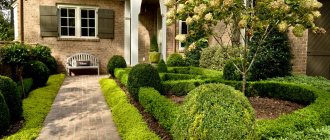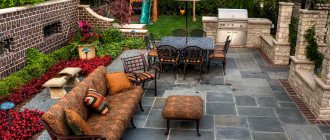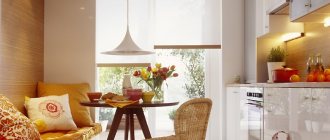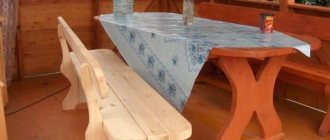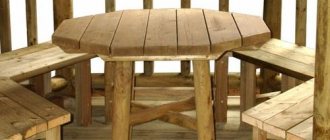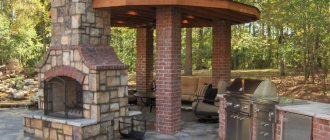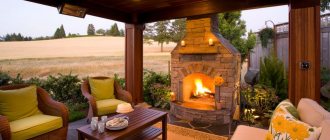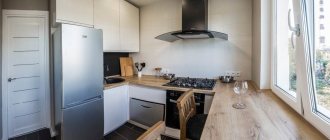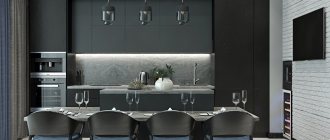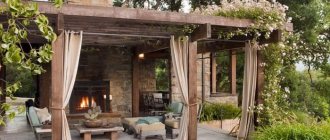Many owners of private houses want to have a gazebo in their yard where they can receive guests or gather with the whole family. This is an ideal outdoor place, having a different shape, but must have a roof that will protect vacationers from rain or other precipitation.
One of the inexpensive solutions for organizing a place to relax is a gazebo made from a profile pipe
In many gazebos you can see benches, tables, and even in some versions a stove combined with a barbecue. How to make a gazebo from a profile pipe? There are several rules that it is highly advisable to adhere to in order for everything to work out the first time.
Advantages and main characteristics of gazebos made of metal profiles
Before you start building a gazebo, you need to determine what material to use for its construction. There are several main types of materials often used for such purposes: metal, wood and stone.
The metal frame made of profile pipe is lightweight and can withstand significant loads
A gazebo made from a profile pipe is a more popular option compared to other materials due to its practicality and durability.
The advantages of using metal material to make this seating area:
- High strength.
- Durability in use.
- An excellent combination with other materials for decoration.
- Possibility of weaving climbing plants, grapes, roses along its base.
- You can build a barbecue or grill with a hood into the gazebo.
In some cases, if the gazebo is light in weight, it can be installed directly on the lawn without making a preliminary foundation. These structures can have a heavy massive structure or, conversely, it can be light and have openwork decor. Gazebos made of metal profiles go well with other materials, namely stone, plastic, wood. There are many options for decorating them.
Semi-closed gazebo with walls made of corrugated sheets
Metal gazebo with wood paneling
Enclosed gazebo with polycarbonate sheathing
Octagonal gazebo with panoramic glazing
There are two types of this design: cast and collapsible. For cast, stationary gazebos, a metal profile is used, which allows them to be assembled in a frame manner and the individual parts connected to each other by welding.
Stationary option
This type of building is being installed permanently. For the frame and lintels, steel profiles, brick and wood are used. A prerequisite for construction is the presence of a foundation. The design of this type is complex, and its creation will require more material and time costs than a collapsible gazebo.
Advantages of a permanent structure:
- The presence of a foundation and profile pipe products give the structure high strength and durability. It can withstand high loads from winds, rainwater and snow.
- During construction, it is possible to use different types of execution. The building can accommodate furniture, barbecue, and stove. Electricity can be supplied to it. This design can be glazed and heated.
- An additional advantage of the structure is the possibility of implementing various types of design.
Choosing a location and with what elements of landscape design you can combine a gazebo
A gazebo made from a profile can be attached to the wall of a structure, or it can be free-standing. It all depends on the size of the private property. The place should be quite sunny and comfortable.
A canopy attached to the house is the optimal solution for small areas
If you plan to install the structure separately from other structures, then you need to correctly calculate the required distance, indicate the possibility of approaching it with a path, path, and choose a sufficiently ventilated place so that it is not stuffy in hot weather.
For a gazebo, it is best to choose a place that is as far away from noise sources as possible, both on your own and on your neighbors’ plots
You can place this resting place under a tree, which will create additional unity with nature thanks to the noise of its foliage, or plant fragrant rose bushes nearby. Many people build ponds, artificially created stone hills, etc. next to this recreation area on their property.
It is also undesirable to place a gazebo near outbuildings, especially if they contain birds or animals
You can apply your own decorating ideas that will be original, aesthetically attractive, and for this there is the opportunity to use old, unnecessary things, giving them a “second life” as an addition to the interior of the gazebo.
Step-by-step instructions: marking and installing poles
Remove the fertile layer of soil from the ground surface at the construction site. If water drains well from the site, then the pit is filled with sand and soil, preferably without vegetation. If the soil is predominantly clayey, then clay is also poured in so that it is removed.
Next, a pit is made for installing pipes up to 90 cm deep. Install a pipe into it and fill it with coarse crushed stone or construction waste.
After this, align the support pillars vertically. They should be fixed in equal position and then concreting should begin. Gazebo diagram
For working with metal, it is very convenient to use a level or plumb line with a magnet. You install the item to be measured in the right place and level the support post without any problems.
Another option for making a foundation is to install blocks on which the gazebo will be installed. With this design, the structure will be raised from the ground level. The blocks must be installed in the corners and in a checkerboard pattern in the middle. This will prevent the pipe from sagging. With an edge of 50 mm, 3 m of pipe will sag without support. The blocks are placed at the same level horizontally. To do this, you can drive pegs in the corners and stretch a string between them.
Racks and bottom trim
When the blocks are installed, suitable pipes are laid around the perimeter.
For the bottom trim, a 50x50 mm pipe is enough, but more is possible. In this case, be sure to check the horizontal level of the pipes. You weld the pipes in the corners. After this, to install the floor from the boards, weld lintels from a pipe with a cross-section of 40x20 mm. Welding work
To ensure that you can safely stand at full height in the gazebo, the racks are made with a height of 2200 mm. In order for the racks to have the necessary rigidity and stand securely, mounting brackets from a metal strip should be welded, as shown in the illustration.
Mounting jibs
Having positioned the stand level, clamp the jibs with clamps and weld them in place. You also scald the pipe at the base.
Railings and top railing
In our gazebo, the height of the railing will be 900 mm. You can make a structure without railings - this is not important, for example, completely sewn up with polycarbonate. For the middle piping (for the railing) and the top, a pipe with a cross-section of 40×20 mm is used. To ensure sufficient rigidity between the bottom trim and the railing, you can weld 950 mm vertical posts from the same pipe.
We make the roof
In our case, the roof of the gazebo will be covered with bitumen shingles. For this purpose, the rafter structure is made of wood. For the frame, timber 75×40 mm is used. For sheathing under the tiles, you can use clapboard. For a more presentable appearance from below, the lining can be replaced with moisture-resistant plywood.
Drive a piece of wood at least 100 mm deep into the open end of the profile pipe on the stand. A length of up to 70 mm should remain sticking out from the top. We will attach the rafters to these plugs. Therefore, the plugs can be cut at the root and at the required angle.
Rafters are cut in quantities of 4 pieces. 2.5 m each. All rafters are connected at one point at the top. They can be knocked down with nails or screws. At the same time, follow the angle; for this, the ends of the beam are cut at an angle. For better reliability, the rafters can be connected to each other with a stainless steel angle.
Final work
Attach a cross beam in the center of the top trim. From it, install the stand perpendicularly towards the top trim of the rafters. This will significantly strengthen the roof structure. After installing and fixing the rafters, you can make the sheathing, and lay plywood or lining on top. The final touch in arranging the roof will be the laying of bitumen shingles. Its installation is carried out from the bottom up, and is nailed with small nails.
Final finishing
At the last stage, the flooring is made from 70x40 mm boards. Small gaps are needed between the boards to allow the wood to swell as humidity changes. Taking this into account, it is not recommended to use floorboards for decking a gazebo. As for the sides of the gazebo, you can use a variety of options for finishing it. For example, weld forging elements, cover the railings with polycarbonate, etc.
So, we learned about how to make a gazebo from metal using a profile pipe. If you have your own experience in performing such work, then leave comments at the end of this article. The provided drawings may also help you. Based on them, you can design your own gazebo made of metal.
Design and development of drawing
Any construction of gazebos for the home must begin with the formation of an idea. But in order to ultimately obtain the expected design of excellent quality, the project must be transferred to paper in all details and details. To do this, you will need to thoroughly think through the project, correctly draw up drawings with dimensions and installation diagrams, and then proceed to the start of construction, strictly adhering to the plan.
Project of a small gazebo with benches along three walls
Gazebo designs, drawings, diagrams
At the very beginning, you need to find a photo of the optimal gazebo of the desired size and structure with a ready-made layout. Take any suitable option as a basis and schematically build your project based on it.
Project of a gazebo with a flat roof and a brick barbecue
You need to decide whether there will be a stove or barbecue in the gazebo, furniture and where it will stand, and also determine the location of the entire structure. This should all be in the preliminary design. A gazebo made from a professional pipe may have its own lighting and therefore it is necessary to provide for these electrical communications.
Next, the necessary measurements are calculated at the site where this structure will be located and transferred to paper. The drawing also needs to indicate the width, length of the gazebo, dimensions and height of the roof. Schematic calculations are made from the side, front, and the location of other interior elements in it is indicated.
Drawing of an open gazebo with a radius polycarbonate roof
Drawing of a gable gazebo with a corrugated roof
Drawing of a gazebo with a hipped roof made of metal tiles
If it is planned to divide the structure into zones, then this should also be displayed on the plan. In the roof project you need to indicate the number and thickness of the floor parts.
Important! It is imperative to indicate the slope of the roof and draw in detail where they connect to the rest of the structure.
According to generally accepted standards, for the comfort of one person staying in any area, about 2 square meters are required. m. and based on these dimensions, you can calculate the dimensions of this structure, which will be ideal for all family members.
Worth considering! A very large or small gazebo will not be as functional or comfortable as the same medium-sized resting place.
Phased construction
Brick gazebos
To make a gazebo, you will need to draw up a detailed plan, according to which you can calculate the amount of materials needed. The drawing indicates the type of structure, exact dimensions, as well as information about the frame and cladding.
When drawing up a drawing, keep in mind that there are standard requirements for gazebos and their dimensions. The height of the structure should not be less than 2.3 m, and each vacationer should have at least 4 square meters. m of building area.
In this case, you can draw up a drawing yourself or choose a ready-made one - both options are acceptable. The main thing is to maintain proportions and sizes. The plan contains a top view of the building and a frontal diagram of the structure.
You can use computer programs and create a 3D model of the gazebo, which will reflect every detail of the future structure. This is especially true if the building has a complex structure. After drawing up the project, the assembly of the frame begins.
Construction of the floor
Before pouring the foundation with concrete, the area is marked using the “Egyptian triangle” method (or any other). Then, in the planned location, a 15-20 cm layer of earth is removed. Sand 5 cm thick is poured into the resulting shallow pit, which is compacted with water.
After this, temporary wooden structures are installed to act as formwork. Next, to strengthen the future foundation, a mesh of reinforcement is laid. It is not possible to weld the mesh elements; experts recommend using only wire fastening. This will eliminate the problem of rust at the joints.
At the final stage, the foundation pit with the mesh is filled with concrete mortar, and the surface of the resulting area is leveled. As an option, classic paving stones are used to create a durable, level floor in the gazebo, but this increases the cost of the work.
Frame installation
To install support pillars, holes up to a meter deep are dug along the edges of the site. Profiled pipes are installed in them and filled with concrete at the base. Sometimes support pillars are simply driven into the ground, which is no less effective, but requires certain skills and physical strength.
After installation, the veins are welded to the posts in two rows. In this case, one row is placed 2 cm from the floor, and the second - 90-150 cm from the first. Transverse sections of frame pipes are mounted along the entire perimeter of the gazebo, except for the area where the door or gate will be installed.
Roof arrangement
Next, they begin to install the top trim, which serves as the basis for the roof. The easiest way is to make a gable roof. To do this, first the pipe sections are connected in pairs on the ground and leveled, and only then the prepared structure is lifted up.
The next step is to weld the roof frame to the pillars. To create a collapsible structure, the supports and roof frame are not welded, but fixed together. In this case, the racks are not installed in the ground, but are mounted on prepared mounts in the floor or foundation.
Collapsible gazebos are more difficult to make, but they are more convenient.
When the installation of the base is completed, the surfaces are primed and painted to protect them from the negative effects of precipitation and corrosion.
Fastening finishing materials
As soon as the paint coating has dried, they begin to sheath the pipe frame. It is possible to create forged gazebos in which decorative elements are attached to the frame frame with bolts or by welding. This option is attractive in appearance, but impractical: such a gazebo does not protect from wind, sun and rain, but serves only to decorate a yard or park. From a practical point of view, suitable materials for cladding are wood, metal profile sheets or polycarbonate, which is popular today, which are easy to process.
The finishing material is cut according to the specified dimensions and holes are made in it for subsequent attachment to the frame. If polycarbonate is used for sheathing, the holes should be slightly wider than the bolts. During a sharp temperature change, this will avoid the appearance of cracks, since the material tends to expand under certain conditions.
After installing the walls, a roofing covering is installed, most often using corrugated sheets or polycarbonate. The transparent polymer allows the sun's rays to pass through, making the gazebo light, but at the same time protects from rain and snow.
Final steps
At the final stage, the door is installed, if it is provided for in the plan.
It is important to correctly calculate each parameter at the drawing stage so that there are no problems when installing the structure
Assembling a gazebo from a metal profile is a simple process that does not require special skills or tools.
Decorating the building
A gazebo made of pipes should not only be practical and functional, but also beautiful and well decorated. You can use different methods of decorating this structure, using natural or artificial material. The use of stone and wood for decorating modern gazebos, as well as any other natural materials, will look aesthetically pleasing and stylish. It all depends on the manifestation of imagination.
To decorate a garden gazebo, you can use the furniture installed in it
The gazebo, decorated with forging elements, looks luxurious
An ordinary tree stump will look unusual, but with a little processing it can be used as a decorative element in a gazebo, and it can also be practical if used as a base under a table and a table top is attached on top of it. This will show closeness to nature and add additional charm to the interior.
An unusual table made from an old stump is a great idea for decorating a garden gazebo
You can also use logs to create benches - this will save money on the purchase of other materials, allows you to use the bases of previously cut trees and gives a special “zest” and primitiveness to the entire interior design.
If desired, you can make a whole set of logs with comfortable benches and a dining table
The use of living plants in the interior will look original and stylish. Climbing types of vegetation can serve as a “living” wall and have an aesthetic appearance.
The simplest option for decorating a gazebo is to plant maiden grapes or clematis around it.
Decorating with curtains or curtains will create a feeling of comfort and tranquility for the people inside. If it is not possible to plant any flowers or other vegetation nearby, you can put potted options that will also look beautiful and stylish.
Lush rose buds look beautiful in flowerpots installed in front of the entrance to the gazebo.
Drawing up and calculation of the project
Making a wooden gazebo for a summer residence
Before you start, you need to eat and calculate all the details. Construction should not bring surprises
Therefore, pay attention to the characteristics of the soil for the construction of the building and the barbecue in the gazebo, the footage of the necessary pipes or profile for the skeleton, the type of cladding, decorations and plants, the presence of additional structures
And of course, it’s worth making a mini estimate and choosing those materials that will fit into your existing budget. After this, make drawings and try to sketch the building. If you don’t have time to draw up drawings, then you can find them on the Internet, where there are hundreds of them. Here's an example:
If you are building a gazebo for yourself, this may not seem necessary. But if you are doing it for a client, then diagrams, layouts and plans can be supplemented with a 3D model.
The sizes are determined depending on the presence of people living on the site. It is worth considering that it is comfortable for people of different builds to be inside. Referring to SNiP standards, it is recommended to build a gazebo for a summer house no less than 3 by 3 meters.
An example of a diagram for building a gazebo
Beautiful options for gazebos with photographs
You need to look at photos of other gazebos made of corrugated pipe, thanks to which you can already come up with a version of your design and build your project based on them.
The photo shows an open gazebo with a stationary metal grill
This is an open type gazebo with a barbecue and a built-in hood. In this photo you can see the ideal separation of two zones: cooking and food consumption, which are located nearby and at the same time do not interfere with each other. Decorating with a small wooden fence visually separates the garden from this recreational structure.
The photo shows a square gazebo with a portable barbecue
The open-type gazebo made from a profile pipe is equipped with wooden furniture and a portable barbecue. The location of a pine tree next to this structure creates a feeling of complete unity with nature. A simple and at the same time practical option can decorate any area.
The photo shows a gazebo of complex shape, decorated with white curtains
This gazebo can be considered a high-budget option, since forged elements, large sizes, stylish wooden and wicker furniture will not be affordable for an ordinary family, but require a large investment of money. Decorating with curtains and dividing the entire structure into two zones: eating and resting, makes this option practical and elegant. The use of climbing plants ideally brings this structure closer to nature, adding the necessary accents.
Installation
Making your own gazebo from polycarbonate
Do-it-yourself construction of an iron gazebo consists of several stages
Please pay attention to compliance not only with the technology of constructing a metal structure, but also with compliance with safety precautions during all of the following work to prevent injuries to builders and breakdowns of portable equipment
Foundation and floor
Depending on the type of construction of the metal gazebo, the method of constructing its foundation is determined. The columnar option is suitable for the construction of lightweight prefabricated structures that do not create excessive load on the supporting pillars. A strip foundation is necessary when constructing a capital structure to prevent distortions.
The foundation should follow the shape of the gazebo to prevent soil subsidence. If a round shape is chosen, you need to build a round foundation; if the gazebo is hexagonal, then the construction of a hexagonal base is required. The most difficult area to construct is the corner.
When choosing one or another option for construction, work begins with marking the perimeter. For support pillars, it is necessary to dig square holes, the lower part of which is filled with crushed stone and sand at the rate of 5-15 cm per layer, then pipes are installed - vertical supports, and they are concreted with a solution. The tape type involves digging a trench around the entire perimeter of the gazebo, installing formwork and reinforcement, and then concreting.
There are also options in floor construction, varying in complexity of work and degree of cost. The most budget-friendly floor can be built by filling the interior of the gazebo with sand. Another cheap option is concreting with an adobe mixture (clay, straw and water) or pouring concrete.
Frame welding
Installation of the gazebo frame begins with the installation of vertical supports by filling a profile aluminum pipe made of metal with cement.
Next, welding work is carried out and the lower and upper horizontal frames are laid, fastened to the vertical supports, after which the homemade walls of the gazebo will acquire the required rigidity.
Depending on the height of the gazebo and the type of its walls (open or closed), a horizontal fence is made at a height of 80-100 cm from the floor level, or a metal sheathing is made on which the walls will be sheathed. If there are doors or windows in the gazebo project, welded structures of the required size for the frames are additionally made in the places where they are installed.
Roof
The construction of the roof begins with the need to make rafters. A profile pipe can be used, and the main elements, for example, polycarbonate, are welded or screwed to the top trim of the frame.
In this case, it is important to make the roof slope at least 15 degrees and the indentation of the outer edge of the roofing material from the wall to be at least 50 cm in size. Depending on the area, location and shape of the roof (for example, round), intermediate iron spacers can be made to securely fix the prefabricated roof covering
Wall cladding
To create comfortable conditions inside the gazebo, the inside walls are sheathed with a variety of suitable materials, which are attached to a pre-prepared metal sheathing.
After treating all open areas of the frame with an anti-corrosion solution to prevent rust, cladding elements are attached to the metal structure. Most often, gazebos are sheathed with your own hands using coatings such as polycarbonate, lining, wooden boards or siding.
Decor
The appearance of the gazebo depends not only on the quality of workmanship and location, but also on the beautiful metal decor.
In the closed type of gazebo design, you can decorate the interior, and open gazebos can be decorated with interesting railings, forging and a variety of homemade decorations or a fabric canopy. In addition, in an open or semi-open portable gazebo or polycarbonate structure, it is better to make a canopy that will protect from the sun and wind.
How to care for a metal gazebo
A gazebo made of metal pipes is practical, but it also has its strengths and weaknesses. This is the place to stay:
- heats up in sunny weather;
- metal parts may rust;
- in the cold season you cannot stay there for a long time, because the metal gets very cold.
To prevent rust from appearing, you need to coat all metal parts with a special anti-rust agent and then paint it. This type of treatment must be repeated every 3-4 years.
It is important to carry out high-quality initial processing and painting of the gazebo frame
It is also necessary to varnish or paint the wooden elements and pieces of furniture located in the gazebo. If the structure was erected correctly and high-quality materials were used, then such a structure will require minimal maintenance.
Much less furniture maintenance will be needed if the walls of the gazebo are closed from rain and snow getting inside.
Many people prefer to relax in nature, cook barbecue and enjoy a sunny day, but no one wants to be in the open rays of the sun or get caught in the rain when the weather changes. To make your vacation comfortable, you need to build a gazebo at your dacha or next to your house, which will combine aesthetic and practical qualities. It will be convenient to sit and relax in good, comfortable conditions and at the same time in close proximity to nature.
Collapsible option
This is a prefabricated installation where the frame is made of square or rectangular pipe products. To cover such a gazebo, plastic or waterproof fabrics are used. This installation has a number of significant advantages:
- Easy assembly. Even inexperienced beginners can handle it with ease.
- Fast installation. You can assemble such a structure in a few hours.
- This structure can be used from early spring to late autumn. Plastic protects from the harmful effects of wind and rain. To protect the gazebo, it is enough to disassemble it and hide it for storage.
- Another significant advantage is mobility. This gazebo can be easily removed and reinstalled if desired.
- For this structure, there is no need to prepare a foundation or take large-diameter pipes.
Photos of gazebos made from profile pipes
Frames, forms and cladding made of iron
Buildings of this kind are assembled using sections from profiles of various shapes or a special corner. It should be borne in mind that the metal itself can be either galvanized or painted. There are cases when welded canopies without parapets are installed on the territory.
A forged gazebo would be an excellent solution, but their cost is quite high, but it is fully justified due to its strength and beauty.
Let's consider options for the shapes of such structures. They usually have polygonal shapes, and each of them is original in its own way.
By design they are distinguished:
1. Open version - can provide maximum visibility and is much cheaper.
2. Closed option - the walls are completely sheathed, in this case vacationers are maximally protected from weather conditions in the form of wind or rain.
Regardless of the purchased option or made independently, designs are divided into:
- stationary - in this case, support pillars are dug in and filled with concrete;
- portable - the supports are fixed using a lower frame that has a horizontal position; the dimensions are much smaller.
Summarizing all of the above, we can conclude that this kind of design can be either a simple option or an exclusive one.
Gazebo foundation
First, the construction site is prepared: trees are cut down, garbage is removed, and the fertile layer of soil is removed. If the pipes are intended to be installed directly into the ground, they must be carefully primed.
Afterwards, holes are drilled 70 - 90 cm deep. The diameter of the pipes is selected independently. A pipe is placed in the hole, then coarse crushed stone and construction waste are poured in, everything is thoroughly compacted. It is checked that the pipe is strictly vertical. Afterwards, cement mortar is poured using M400 cement, sand and water. The resulting mixture should be slightly liquid in order to penetrate deep into the pit.
The main thing is that the vertical position of the rack is checked not only using a building level, but using a plumb line to avoid significant errors. If you have metal stands, it is convenient to use magnetic plumbs.
If there is a need to slightly raise the structure (make it higher), then you can install the frame on blocks from the foundation. It is irrational to use whole blocks, so they can be cut into two parts for the gazebo. To do this, use a diamond blade on an angle grinder.
The resulting figures are placed according to the principle: in each corner there is one cube, between them there are 4 more pieces, in the center there are 4 more in a checkerboard pattern. Blocks are used to avoid possible deflection of the structure.
Bitumen mastic is needed to prevent the concrete from beginning to absorb excess moisture. It can also be replaced with resin, but from an aesthetic point of view this is not recommended. Ruberoid will last no more than two years. Blocks must be displayed at the same level. To do this you need:
- Use a laser level.
- Apply the rail.
- Use a long cord.
What materials are best to use?
As for the main consumable material, we have already decided on it - this is a metal profile, which is easy to work with and therefore is used in most cases. We recommend using products with a wall thickness of at least 0.2 centimeters. Although too thick pipes should also not be used - these are often sold by the kilogram, and therefore, with the same external dimensions, will cost much more.
If for one reason or another you prefer round products, then use them with the same wall thickness. It is more difficult to work with them (in particular, to weld), but if you have experience and skills, you can take a risk - such pipes are cheaper than rectangular ones. There is another option - using a metal corner. However, the thickness of the latter should already be somewhat greater (about 0.25-0.3 centimeters) due to its lower rigidity. Such a design would look very good under the cladding.
All this was said about steel, but you should know that corrugated pipes (as well as the same angles) are also made from aluminum. In this case, the weight of the entire gazebo will be less, which is very important when building a collapsible structure. However, all this will cost several times more.
Design examples
The options for metal garden gazebos in suburban areas are very numerous, but not every person has a bright enough imagination to independently develop the design of a summer house. For this reason, it is worth considering some interesting examples of how other owners came out of the situation with dignity.
Typically, metal gazebos have a rounded shape, but it can be difficult to make such structures yourself, so square structures are not that uncommon. They may look less pretentious than sophisticated round models, but they are accessible to everyone. The photo shows a vivid example of how even a simple square gazebo can be quite cozy - all it lacks is a wooden table and chairs in the style of an outdoor cafe. The semi-open dacha structure itself provides some protection from the wind, and if the owner has chosen the location wisely, then the winds in this region most likely blow predominantly from the side where the canopy is protected by bushes. By the way, just such a building can be built together with a utility block, because under a similar canopy, which should simply be divided into two parts, a woodpile can be successfully organized. The latter can be a good protection from the wind.
You don’t have to invent anything incredible at all, making ordinary benches the basis for the gazebo. Often such designs are extremely simple. They are not always equipped with a table, but by the time the seats are installed, the owner already has not only the frame of the building, but also the furniture in it. The supporting pillars will be a continuation of the edges of the bench. Most often, structures of this type are made completely open, because the choice in favor of a bench already indicates a desire to be on the street.
An octagonal gazebo made of metal may be no different in design from those described above, or it may be exquisite, as in the photograph. Naturally, beauty will require additional effort - at a minimum, the owner must be able to use a welding machine, as well as make shaped structures from metal.
If we talk about decorating a metal gazebo, you can pay attention to the fact that metal parts do not have to be beautiful - the function of adding beauty can be performed by other elements of the interior and exterior, for example, a well-groomed lawn, as well as low bushes planted along the contour will add to the building and liveliness and charm. Curtains will not make an open gazebo insulated, but they will create a secluded atmosphere inside it, imbued with comfort.
Properly selected furniture will also add comfort.
Curtains will not make the open gazebo insulated, but they will create a secluded atmosphere inside it, imbued with comfort. Properly selected furniture will also add comfort.
